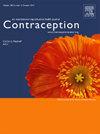Procedural abortion in individuals with opioid dependence: Patient characteristics and pain experience
IF 2.3
2区 医学
Q1 OBSTETRICS & GYNECOLOGY
引用次数: 0
Abstract
Objectives
To describe the prevalence and characteristics of individuals with opioid-dependence who have procedural abortions, and to compare their experience of procedural pain to individuals without opioid-dependence.
Study design
Cross-sectional study of procedural abortion patients at a high-volume ambulatory abortion practice. We offered an anonymous survey to all procedural abortion patients which included medical and demographic information, assessment of opioid dependence with the Rapid Opioid Dependence Screen (RODS), measurement of procedural pain, and satisfaction with pain control.
Results
We approached 1888 individuals, 1553 (82%) completed the survey and 1525 were included in analysis. Eighty-eight participants screened positive for opioid-dependence (5.9%). Opioid-dependent participants were older, more likely to use other drugs, pay for abortion with insurance, report chronic pain, disability, anxiety, depression, prior abortion, and more frequently presented at 15+ weeks. Opioid-dependent patients reported higher mean pain scores (35 vs. 22.5, p = 0.002), with a mean difference of 7.73 in logistic regression analysis accounting for relevant demographic and medical characteristics (p = 0.041). No interaction was seen between opioid-dependence and effect of intravenous (IV) moderate sedation, with reduction in mean pain scores of 13.76 points in opioid-dependent patients versus 14.54 among those without (p = 0.937). The odds unacceptable pain control did not differ between opioid-dependent and non-dependent individuals (OR 1.73, p = 0.18).
Conclusions
Procedural abortion patients with opioid-dependence differ from those without along several reproductive and demographic factors. They have higher mean pain scores but similar improvement in pain with IV moderate sedation. Satisfaction with pain control is similar for patients with and without opioid dependence.
Implications
Intravenous moderate sedation is effective in reducing pain in patients with opioid-dependence, despite their overall higher pain scores. It should not be restricted in these patients due to concerns for ineffectiveness as it may be an important factor in improving the abortion experience for these marginalized patients.
阿片类药物依赖患者的手术流产:患者特征和疼痛经历。
目的:描述阿片类药物依赖者手术流产的患病率和特征,并将其手术疼痛经历与非阿片类药物依赖者进行比较。研究设计:在一个大容量的门诊流产诊所对手术流产患者进行横断面研究。我们对所有手术流产患者进行了匿名调查,包括医学和人口统计信息、阿片类药物依赖快速筛查(rod)评估、手术疼痛测量和疼痛控制满意度。结果:共接触1888人,1553人(82%)完成调查,1525人纳入分析。88名参与者阿片类药物依赖筛查呈阳性(5.9%)。阿片类药物依赖的参与者年龄较大,更有可能使用其他药物,用保险支付流产费用,报告慢性疼痛,残疾,焦虑,抑郁,既往流产,并且更频繁出现在15周以上。阿片类药物依赖患者的平均疼痛评分较高(35比22.5,p = 0.002),考虑到相关人口统计学和医学特征,logistic回归分析的平均差异为7.73 (p = 0.041)。阿片类药物依赖与静脉(IV)中度镇静效果之间没有相互作用,阿片类药物依赖患者的平均疼痛评分降低13.76分,而非静脉(IV)中度镇静患者的平均疼痛评分降低14.54分(p = 0.937)。阿片类药物依赖者和非阿片类药物依赖者之间无法接受疼痛控制的几率没有差异(OR 1.73, p = 0.18)。结论:阿片类药物依赖的手术流产患者与无阿片类药物依赖的手术流产患者存在生殖和人口统计学方面的差异。他们的平均疼痛评分更高,但静脉注射适度镇静后疼痛的改善程度相似。阿片类药物依赖患者和非阿片类药物依赖患者对疼痛控制的满意度相似。结论:尽管阿片类药物依赖患者的总体疼痛评分较高,但静脉注射中度镇静可有效减轻患者的疼痛。由于担心无效,不应限制在这些患者中使用,因为它可能是改善这些边缘患者流产体验的重要因素。
本文章由计算机程序翻译,如有差异,请以英文原文为准。
求助全文
约1分钟内获得全文
求助全文
来源期刊

Contraception
医学-妇产科学
CiteScore
4.70
自引率
17.20%
发文量
211
审稿时长
69 days
期刊介绍:
Contraception has an open access mirror journal Contraception: X, sharing the same aims and scope, editorial team, submission system and rigorous peer review.
The journal Contraception wishes to advance reproductive health through the rapid publication of the best and most interesting new scholarship regarding contraception and related fields such as abortion. The journal welcomes manuscripts from investigators working in the laboratory, clinical and social sciences, as well as public health and health professions education.
 求助内容:
求助内容: 应助结果提醒方式:
应助结果提醒方式:


